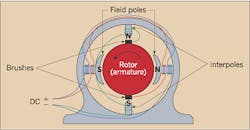The first type of motor built is still in widespread use
In the late 1800s, several inventors built the first working motors, which used direct current (DC) power. After the invention of the induction motor, alternating current (AC) machines largely replaced DC machines in most applications. However, DC motors still have many uses.
The advantages.
The greatest advantage of DC motors may be speed control. Since speed is directly proportional to armature voltage and inversely proportional to the magnetic flux produced by the poles, adjusting the armature voltage and/or the field current will change the rotor speed. Today, adjustable frequency drives can provide precise speed control for AC motors, but they do so at the expense of power quality, as the solid-state switching devices in the drives produce a rich harmonic spectrum. The DC motor has no adverse effects on power quality.
The drawbacks.
Power supply, initial cost, and maintenance requirements are the negatives associated with DC motors.
-
Rectification must be provided for any DC motors supplied from the grid. It can also cause power quality problems.
-
The construction of a DC motor is considerably more complicated and expensive than that of an AC motor, primarily due to the commutator, brushes, and armature windings. An induction motor requires no commutator or brushes, and most use cast squirrel-cage rotor bars instead of true windings — two huge simplifications.
-
Maintenance of the brush/commutator assembly is significant compared to that of induction motor designs.
In spite of the drawbacks, DC motors are in wide use, particularly in niche applications like cars and small appliances.
Permanent magnet motors.
Here, permanent magnets instead of armature windings are mounted on the rotor. Since the magnetic field produced on the rotor is limited in strength and isn't controllable, permanent magnet motors are typically small and produce little horsepower.
Series motors.
Series motors connect the field windings in series with the armature. Series motors lack good speed regulation, but are well-suited for high-torque loads like power tools and automobile starters because of their high torque production and compact size.
Shunt motors.
Shunt motors use high-resistance field windings connected in parallel with the armature. Varying the field resistance changes the motor speed. Shunt motors are prone to armature reaction, a distortion and weakening of the flux generated by the poles that results in commutation problems evidenced by sparking at the brushes. Installing additional poles, called interpoles, on the stator between the main poles wired in series with the armature reduces armature reaction.
Compound motors.
Here, the concept of the series and shunt designs are combined. The Figure above shows one way of wiring a compound motor with interpoles. The blue lines indicate the shunt field, the red lines designate the series field, and the green lines show the interpole windings in series with the armature.
After more than a century, DC motors are still in widespread use, and thanks to niche applications that show no signs of disappearing, they'll be around for many years to come.
